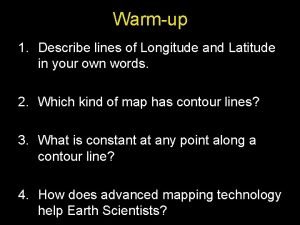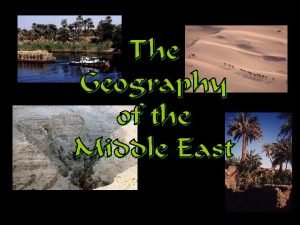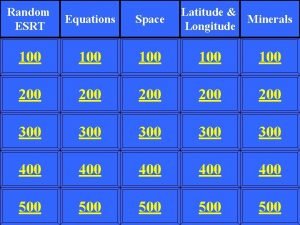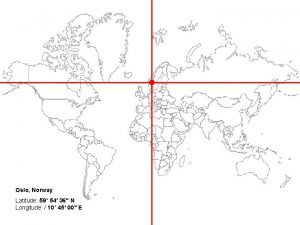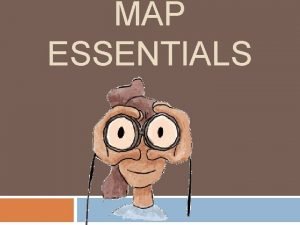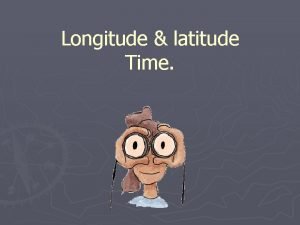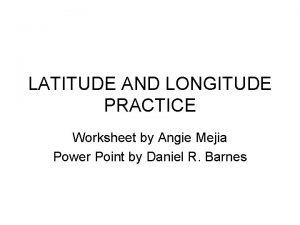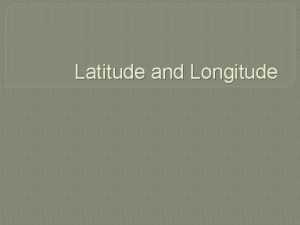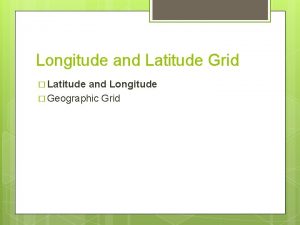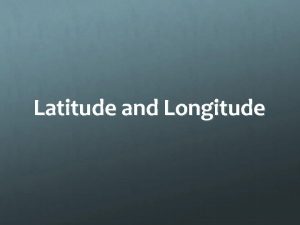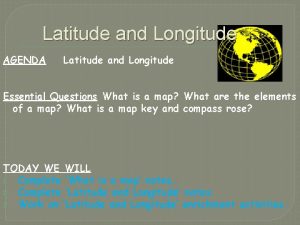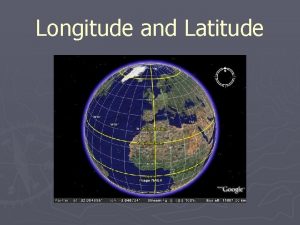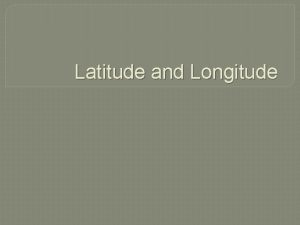Latitude and Longitude How do we find places








- Slides: 8

Latitude and Longitude How do we find places on maps?

• Latitude and Longitude (3 min basics) • Lat video clips – (6 m-945) (945 -1245) (1245 -1425) Longitude Video clips (1445 -18)

Latitude What is Latitude? • • Lines of Latitude run horizontally Latitude is measured in degrees. The Equator is 0 degrees Latitude. Lines of Latitude locate places North or South of the Equator. • The North Pole is 90 degrees N Latitude, and the South Pole is 90 degrees S Latitude.

Longitude • Lines of Longitude run vertically. • They are also called Meridians. • The Prime Meridian is found in Greenwich, England. • The Prime Meridian is 0 degrees Longitude. • Lines of Longitude locate places East or West of the Prime Meridian. • There are 180 degrees of east Longitude, and 180 degrees of west Longitude.

Time Zones • Time zones are broad strips that measure 15 degrees wide. • Time zones differ from their neighboring time zones by 1 hour. • The continental U. S. has 4 time zones, Eastern, Central, Mountain, and Pacific. • In the Spring we shift the clocks 1 hour ahead. This is called Daylight Saving Time. • In the Fall we shift the clocks 1 hour back.

Time Zones (cont…) Local Time and Universal Time Local Time- is what we use everyday, and regulates our lives. Examples of Local Time are: meal time, sleep time, work time, and school time Universal Time- is what we use when we need a time that is agreed upon marking time world-wide. An example when Universal Time was used was when a supernova in 1987 was first seen. Astronomers, and Astronauts use Universal Time. .

Time Zones (cont…. ) • Greenwich Mean Time- is the time that is registered at Greenwich, England. **Greenwich Mean Time is another name for Universal Time. The International Dateline was established following the 180 th meridian, where ever we cross it the date advances 1 day ( if you are going west), or goes back 1 day (if you are going east).

Summary 1. What do lines of Latitude and Longitude combine to make? A grid. 2. Compare and Contrast Latitude and Longitude. Latitude- horizontal, north- south, parallels Longitude- vertical, east-west, meridians 3. What is 0 degrees Latitude? Equator 4. What is 0 degrees Longitude? Prime Meridian 5. How many time zones do we have in the U. S. A. ? 4 - Eastern, Central, Mountain, Pacific 6. Explain the difference between Local Time, and Universal Time. Local time- used everyday Universal Time- is used for a planetary event, or for astronomy
